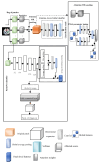Fuzzy Optimized Attention Network with Multi-Instance Deep Learning (FOAN-MIDL) for Alzheimer's Disease Diagnosis with Structural Magnetic Resonance Imaging (sMRI)
- PMID: 40564837
- PMCID: PMC12192201
- DOI: 10.3390/diagnostics15121516
Fuzzy Optimized Attention Network with Multi-Instance Deep Learning (FOAN-MIDL) for Alzheimer's Disease Diagnosis with Structural Magnetic Resonance Imaging (sMRI)
Abstract
Background/Objectives: Alzheimer's disease (AD) is the leading cause of dementia and is characterized by progressive neurodegeneration, resulting in cognitive impairment and structural brain changes. Although no curative treatment exists, pharmacological therapies like cholinesterase inhibitors and NMDA receptor antagonists may deliver symptomatic relief and modestly delay disease progression. Structural magnetic resonance imaging (sMRI) is a commonly utilized modality for the diagnosis of brain neurological diseases and may indicate abnormalities. However, improving the recognition of discriminative characteristics is the primary difficulty in diagnosis utilizing sMRI. Methods: To tackle this problem, the Fuzzy Optimized Attention Network with Multi-Instance Deep Learning (FOA-MIDL) system is presented for the prodromal phase of mild cognitive impairment (MCI) and the initial detection of AD. Results: An attention technique to estimate the weight of every case is presented: the fuzzy salp swarm algorithm (FSSA). The swarming actions of salps in oceans serve as the inspiration for the FSSA. When moving, the nutrient gradients influence the movement of leading salps during global search exploration, while the followers fully explore their local environment to adjust the classifiers' parameters. To balance the relative contributions of every patch and produce a global distinct weighted image for the entire brain framework, the attention multi-instance learning (MIL) pooling procedure is developed. Attention-aware global classifiers are presented to improve the understanding of the integral characteristics and form judgments for AD-related categorization. The Alzheimer's Disease Neuroimaging Initiative (ADNI) and the Australian Imaging, Biomarker, and Lifestyle Flagship Study on Ageing (AIBL) provided the two datasets (ADNI and AIBL) utilized in this work. Conclusions: Compared to many cutting-edge techniques, the findings demonstrate that the FOA-MIDL system may determine discriminative pathological areas and offer improved classification efficacy in terms of sensitivity (SEN), specificity (SPE), and accuracy.
Keywords: Alzheimer’s disease (AD); attention mechanism; convolutional neural network (CNN); fuzzy salp swarm algorithm (FSSA); multi-instance deep learning (MIDL); structural magnetic resonance imaging (sMRI).
Conflict of interest statement
The authors declare no conflicts of interest.
Figures
Similar articles
-
Predicting cognitive decline: Deep-learning reveals subtle brain changes in pre-MCI stage.J Prev Alzheimers Dis. 2025 May;12(5):100079. doi: 10.1016/j.tjpad.2025.100079. Epub 2025 Feb 6. J Prev Alzheimers Dis. 2025. PMID: 39920001 Free PMC article.
-
A 3D decoupling Alzheimer's disease prediction network based on structural MRI.Health Inf Sci Syst. 2025 Jan 17;13(1):17. doi: 10.1007/s13755-024-00333-3. eCollection 2025 Dec. Health Inf Sci Syst. 2025. PMID: 39846055
-
18F PET with florbetapir for the early diagnosis of Alzheimer's disease dementia and other dementias in people with mild cognitive impairment (MCI).Cochrane Database Syst Rev. 2017 Nov 22;11(11):CD012216. doi: 10.1002/14651858.CD012216.pub2. Cochrane Database Syst Rev. 2017. PMID: 29164603 Free PMC article.
-
Donepezil for dementia due to Alzheimer's disease.Cochrane Database Syst Rev. 2018 Jun 18;6(6):CD001190. doi: 10.1002/14651858.CD001190.pub3. Cochrane Database Syst Rev. 2018. PMID: 29923184 Free PMC article.
-
Nimodipine for primary degenerative, mixed and vascular dementia.Cochrane Database Syst Rev. 2001;(1):CD000147. doi: 10.1002/14651858.CD000147. Cochrane Database Syst Rev. 2001. Update in: Cochrane Database Syst Rev. 2002;(3):CD000147. doi: 10.1002/14651858.CD000147. PMID: 11279679 Updated.
References
-
- Vounou M., Janousova E., Wolz R., Stein J.L., Thompson P.M., Rueckert D., Montana G., Alzheimer’s Disease Neuroimaging Initiative Sparse reduced-rank regression detects genetic associations with voxel-wise longitudinal phenotypes in Alzheimer’s disease. Neuroimage. 2012;60:700–716. doi: 10.1016/j.neuroimage.2011.12.029. - DOI - PMC - PubMed
LinkOut - more resources
Full Text Sources






